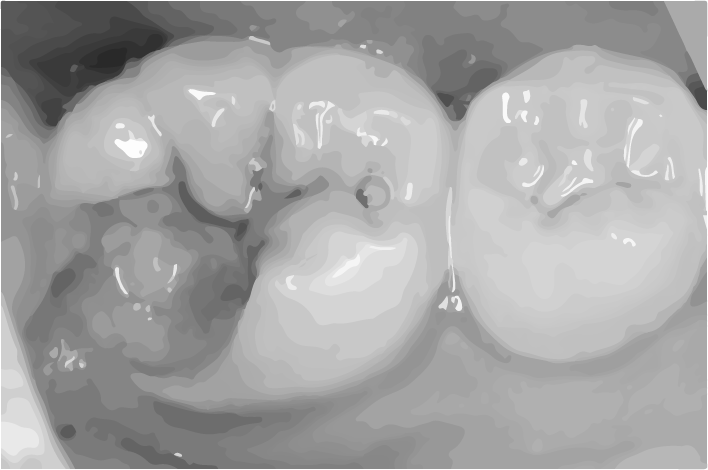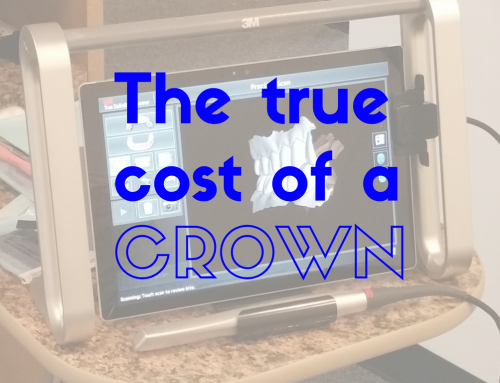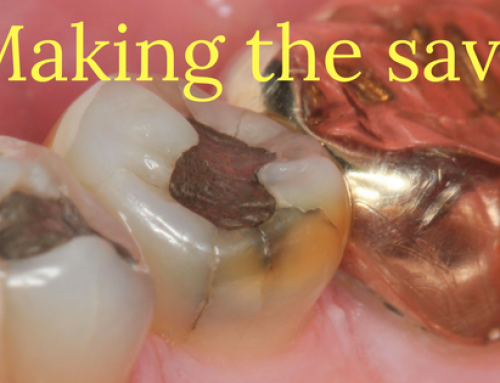 This is the story of a tooth. A very groovy tooth. It’s also about the patient who is attached to that tooth. You see, I saw this patient last week. She presented to my office with a “broken tooth.”
This is the story of a tooth. A very groovy tooth. It’s also about the patient who is attached to that tooth. You see, I saw this patient last week. She presented to my office with a “broken tooth.”
All dentists know that what a patient thinks of as “a broken tooth” can range from a tiny chip to a huge piece missing. When I saw her on the schedule I didn’t know what to expect, but I did know that she hadn’t been seen at our office for almost 5 years and she had some previous treatment recommended that hadn’t been completed.
The patient told me that she had broken the tooth when she was chewing on something kind of hard. The tooth hadn’t been hurting her before it broke, but now that it was broken, it was kind of sensitive. Especially when she chewed.
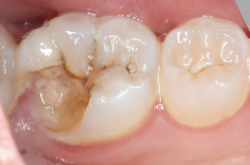 Then I took a look. This was a seriously broken tooth! About half of the back side of the tooth had broken off and it was broken all the way down to the gum line. I was actually a little surprised that the tooth didn’t hurt more. Usually when you’ve got a break this big it’s because 1) there is a large cavity that had undermined that part of the tooth or 2) the tooth had a large filling that had come out. The records showed that the tooth had never had a filling before, but we had recommended cleaning out and filling the pits and fissures (aka: grooves) on the bite surface of the tooth. You’ll notice in the photo that this tooth has very darkly stained grooves. This patient is a high risk for tooth decay due to her diet and these deep grooves are a large risk factor for her as well.
Then I took a look. This was a seriously broken tooth! About half of the back side of the tooth had broken off and it was broken all the way down to the gum line. I was actually a little surprised that the tooth didn’t hurt more. Usually when you’ve got a break this big it’s because 1) there is a large cavity that had undermined that part of the tooth or 2) the tooth had a large filling that had come out. The records showed that the tooth had never had a filling before, but we had recommended cleaning out and filling the pits and fissures (aka: grooves) on the bite surface of the tooth. You’ll notice in the photo that this tooth has very darkly stained grooves. This patient is a high risk for tooth decay due to her diet and these deep grooves are a large risk factor for her as well.
You’re probably thinking, “hey wait a second, doc. Almost half of that tooth is broken off. Those pits and fissures couldn’t have caused that! They’re just little tiny grooves! It must have been an olive pit or something!” I was thinking the same thing. So I decided to do a little detective work.
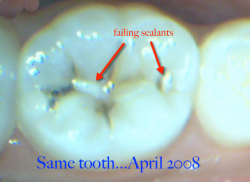 I had a photo taken with an intraoral camera of this tooth from April 2008. It actually showed a little bit of failing pit and fissure sealant hanging in there. Even then you could see those dark grooves. This visit in 2008 was when we recommended she have those grooves cleaned out and filled.
I had a photo taken with an intraoral camera of this tooth from April 2008. It actually showed a little bit of failing pit and fissure sealant hanging in there. Even then you could see those dark grooves. This visit in 2008 was when we recommended she have those grooves cleaned out and filled.
Unfortunately, that didn’t happen. The story picks back up at the beginning of February, 2013. A big piece of the tooth came off when she was eating something hard while watching the Super Bowl. It started hurting a little bit after that, and she knew she’d have to do something.
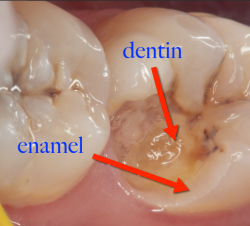 The tooth did have a lot of decay, and the decay had undermined the broken part of the tooth. How do I know that? Take a look at this photo of the same tooth at a different angle. The hard, outer layer of tooth is called enamel and is much more resistant to decay than the softer, inner layer of tooth, called dentin. Grooves are weakened areas in the enamel and many grooves communicate right into the dentin.
The tooth did have a lot of decay, and the decay had undermined the broken part of the tooth. How do I know that? Take a look at this photo of the same tooth at a different angle. The hard, outer layer of tooth is called enamel and is much more resistant to decay than the softer, inner layer of tooth, called dentin. Grooves are weakened areas in the enamel and many grooves communicate right into the dentin.
Decay causing bacteria cover the teeth, but they prefer deep, dark wet places. Places like pits and fissures. 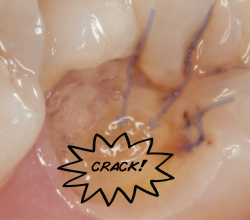 And since these grooves are actually weakened areas, the bugs and the acid they produce can slip right through the harder enamel layer and start decaying the dentin. You can actually see the path the decay took over time, right through these deep grooves into the soft, defenseless dentin. Over a period of years, this decay grew into a big cavity and undermined the enamel layer above it. Then, on Super Bowl Sunday, the patient bit onto the tooth just right, and crack! The tooth broke away leaving this soft, affected dentin layer.
And since these grooves are actually weakened areas, the bugs and the acid they produce can slip right through the harder enamel layer and start decaying the dentin. You can actually see the path the decay took over time, right through these deep grooves into the soft, defenseless dentin. Over a period of years, this decay grew into a big cavity and undermined the enamel layer above it. Then, on Super Bowl Sunday, the patient bit onto the tooth just right, and crack! The tooth broke away leaving this soft, affected dentin layer.
So that’s my groovy story. It’s kind of a sad story, because the patient is either going to need a root canal and a crown or she’s going to lose the tooth. But like all good stories, this one has a moral. The moral of this story is to have your grooves evaluated! If you’ve got deep pits and fissures, you have a greater risk for this type of decay. And, left untreated, it can cause a lot of dental strife!
Did you find this post groovy? Mysterious? I’d love to hear about it! You can share any Mead Family Dental post with a “Like” on Facebook, a “+1″ on Google+ or you can even “Tweet” it with Twitter! All you need to do is hover over the heart shaped button next to the title of the post. Or you can leave a comment by clicking on the balloon shaped icon next to the title.
If you’re looking for a dentist in Saginaw, we’re always happy to accept new patients! You can request an appointment online or call the office at (989) 799-9133. And, as always, you can email me at alan@meadfamilydental.com. I always answer my own emails!

